Next Wave in Cloud: Unified Cloud Services
February 2, 2023
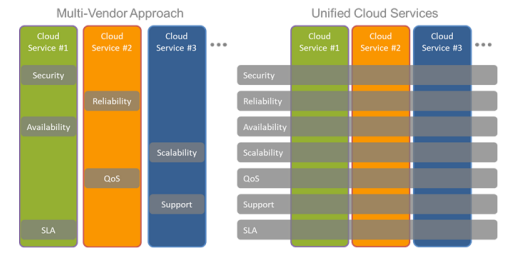
Executive Summary
“The Cloud” has moved from bleeding edge to competitive advantage over the last 5 years as enterprises from small to large have realized the cloud’s advantages. Elimination or significant reduction in CAPEX expenditures, less complexity and maintenance at the desktop, better centralization and consistency of service, virtually infinite scalability and flexibility in infrastructure and lower IT resource requirements have all been proven reasons to move IT services from in-house/on-premises to outsourced cloud service providers. In a cloud services environment, the service reside in a secure, reliable, high performance, infinitely scalable “cloud” datacenter, delivered by a company that is an expert in creating, delivering and maintaining those services. Services such as communications, computing, storage and mobility can now be delivered from the cloud by services providers that understand how to configure, deploy, and maintain those services reliably securely. Once deployed, Cloud Services can be easily self-managed and deliver incredible benefits to an enterprise in the form of lower total cost of ownership, higher productivity, higher levels of business continuity, incredible infrastructure flexibility and the ability for the enterprise to focus virtually all its resources on its core business and customers.
With all the advantages of cloud services, it’s no wonder the number of cloud service providers has exploded onto the market, offering a multitude of IT services from CRM to storage to communications. Each service provider seems to be offering a single specific cloud service and extolling the benefits of moving that particular service to the cloud. Enterprises, however, must look at the bigger picture, which involves evaluating the migration of multiple IT services to the cloud. This is a much more challenging proposition if implemented with multiple cloud providers. Inconsistent service attributes, redundant and often confusing service operations, and significant OPEX costs can throw “cold water” over the compelling decision to move to the cloud.
A new generation of cloud service providers, unified cloud service providers, is stepping forward to deliver the next wave in cloud: Unified Cloud Services (UCS). UCS providers deliver multiple cloud services in a seamlessly integrated solution, significantly lowering overall OPEX, providing consistent service attributes, and offering higher levels of productivity and efficiency through integrated design. UCS providers can offer enterprises higher levels of security, quality of service, reliability, availability, scalability and support than a multi-vendor approach.
PanTerra’s Streams unified cloud service solution delivers unified communications, file sharing and mobility services in a seamlessly integration platform, delivered 100% from the cloud. It is ideally suited for mid-market enterprises that want the advantages of cloud services with higher levels of security, reliability, quality of service, scalability and support, while lowering overall TCO over multiple separate cloud services.
Benefits of Moving Your IT Services to the Cloud?

IT services today are numerous and daunting. IT departments must deal with everything from file/storage services to communication services. Unfortunately, for many IT departments, these services typically have been implemented individually over a long period of time, resulting in a mish-mash of obsolete on-premises equipment, redundant connectivity and networking configurations and complex and often frustrating maintenance procedures.
“Disparate on-premises equipment and services hobbled together over time can cost an enterprise significantly in obsolescence costs, inefficient connectivity costs, and inefficient IT resource costs required to managed and administer dis-joint services.”
In recent years, the alternative of moving or implementing your IT services in the cloud from a cloud service provider has gained momentum as a viable real alternative to on-premises CAPEX intensive solutions of the past. Indeed, there are many benefits to moving many of your company’s IT services to the cloud including reduced or eliminated CAPEX costs, maximum infrastructure flexibility, global service consistency across multiple geographic locations, efficient support or remote and mobile workers and immunity to local disasters that might otherwise impact business operations.
Cloud service providers have responded to demand by building out highly scalable, reliable datacenters to deliver the cloud service, creating redundant connectivity WAN networks to ensure reliable operation of the service and building auto-recovery capability into the service to improve availability of the service. 24/7 support is another capability that high end cloud service providers are delivering as well.
Thus today, enterprises are evaluating and implementing IT services such as CRM, file storage, communications and collaboration in the cloud and reaping all the benefits for both employees and IT departments alike.
Challenges of Moving Multiple Services to the Cloud
While the benefits of moving individual IT services to the cloud are many as described in the previous section, the challenges of moving multiple IT services to the cloud can be extremely daunting, especially if each individual service is delivered from a separate cloud service provider.
By moving an enterprise’s IT services to a unified cloud IT managed service provider, enterprises and their employees gain access to the latest and greatest services since the service provider’s sole focus and capabilities center on developing and deploying leading edge IT services. In addition, cloud-based IT services are consistently available from any device anywhere in the world, making mobile employees more productive because they have access to all their IT services in a consistent manner. An example of this are unified communications services. Unified communications services provided by multiple on- premises solutions across an enterprise can be inconsistent and potentially incompatible for mobile employees, resulting in inefficient or no access to information or communications critical to doing business. Cloud based unified communications delivers consistent information and communications to employees anywhere in the world in real time, thus maximizing employee productivity.

In this multi-vendor approach, not only are there complexities with dealing with multiple service vendors, the real challenge is dealing with service attribute inconsistencies. Security, reliability, QoS, and support differences between service providers can be challenging for IT departments to manage and become frustration points for workers that see disparate or inconsistent feature capabilities.
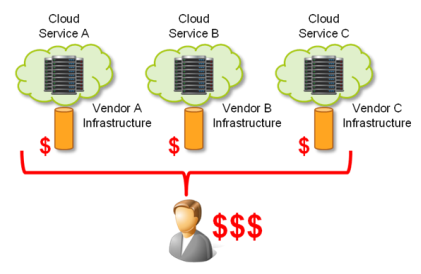
Moving multiple IT services to different cloud providers can also have a negative effect on cash flow economics and Total Cost of Operations (TCO) metrics. Each cloud service provider must charge a minimum “entry fee” to deliver their service. This minimum monthly charge covers their cost of delivering the service and includes the cost of their datacenters, networks and operations personnel. Typically for cloud service providers, this minimum is in the range of $20 to $50 per user per month. Migrating a single service to the cloud requires an enterprise to pay this expense once. Migrating several services to different cloud service providers requires an enterprise to pay this minimum monthly expense multiple times. This can add up to significantly monthly expenses on a per user basis. And there is little to know benefit to the enterprise in return for such replicated expenses. There is no inherent guaranteed additional level of reliability, availability or consistent service attribute as a result of multiple cloud service providers and yet the customer is hit with multiple minimum per month charges for each cloud service which can end up being over $150 per user per month.

Finally, when moving multiple IT services to multiple separate cloud providers, there can be both unintended consequences (negative impacting interactions between services) as well as inefficient or ineffective integration. Imagine uploading multiple terabytes of files to your file storage service provider at the same time you are trying to conduct an HD video conference through your collaboration service provider. Redundant operations such as having to re-enter email addresses for both file sharing and setting up a video conference with those same users can be both non productive and frustrating for end users.
Cloud 2.0: Unified Cloud Services (UCS)
Enter in a new generation of cloud services: Unified Cloud Services (UCS), delivered by a new breed of cloud service providers: Unified Cloud Service providers. As service providers create a reliable, scalable and secure cloud infrastructure, it makes sense to monetize that infrastructure over more than a single cloud service. This creates a better TCO (Total Cost of Operations) metric for the end customer, more consistency in the IT services and their attributes delivered to the enterprise and forms the basis for integrating those services together to deliver a more cohesive, productive solution to the enterprise.
Of course, in order to truly deliver on multiple cloud services, the UCS provider must implement a “superset” cloud infrastructure so that all of the attributes of each service are delivered at or above the expectation level of the industry and customer. Key attributes include: security, reliability, availability, scalability, QoS, SLAs and support.
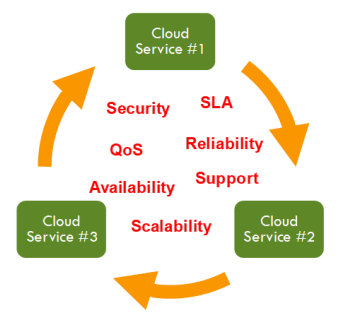
Only when a UCS provider can deliver a “superset” cloud infrastructure that meets the needs of each cloud service for each of these attributes can the UCS provider truly deliver a solution that significantly benefits the customer. But when done right, UCS delivers compelling benefits to an enterprise.
Benefits of Unified Cloud Services
Consistent Service Attributes
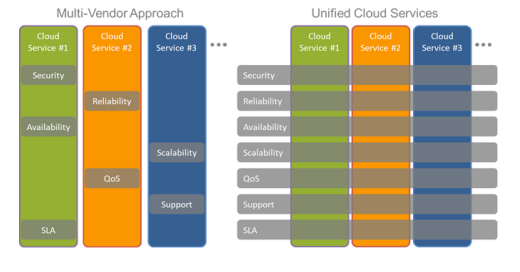
One of the biggest advantages of using a unified cloud service provider is achieving consistent service attributes across all your cloud services. This is extremely important to IT department as well as users of the service. Can you imagine having different support hours or methods of accessing support (Calling versus forums only) for different cloud services! Or having different (or none at all) SLA levels for different cloud services from different cloud service providers. This type of environment would increase confusion and frustration.
UCS providers deliver consistent attributes across all their services, maximizing productivity while minimizing IT complexities and operational inconsistencies. The attributes consistently delivered across all UCS services include:
Security – Achieve a higher more consistent level of security across all your cloud services with a UCS approach. UCS providers must implement secure hardened data centers, encrypted transfers and most of all multi-phase authentications at the access devices. It is the last item that is extremely important as mobile devices and multiple devices become prevalent in the work world. Enterprises can bolt on external 3rd party security layers, but having security built into the cloud services delivered by a UCS provider is important.
Reliability – UCS providers build highly reliable services using a combination of hardware and software redundancy, preventative monitoring and maintenance, the use of highly reliable components and locating their datacenters in low disaster event geographies. This creates a system in which any single failure cannot cause a service outage.
Availability – Availability works hand in hand with reliability but adds an additional requirement of recovery time should an outage event occur. The reliability and time to recover from an event determines the availability of a cloud service. UCS providers build full automation into the recovery of a service, minimizing down time and maximizing availability.
Scalability – Supporting cloud scaling for a single cloud service is challenging. Supporting cloud scaling for multiple cloud services requires true architectural expertise in cloud scaling. UCS providers have this level of expertise in order to scale multiple cloud services across individual customers as well as across their entire multi-tenant base.
QoS – While some single service cloud providers attempt to provide some level of Quality of Service (QoS) across their own service, customers are left to manage overall QoS across all their cloud services, which is for all practical purposes virtually impossible. UCS providers on the other hand, have the ability to “see” all their services and what resources each service is attempting to acquire at any given time. UCS providers can apply “global QoS” across all their services to ensure overall QoS and service prioritization is enforced and maintained.
Support – Having different support levels for each cloud service in a multi-vendor single service environment can be confusing and frustrating for most companies. UCS providers provide consistent levels of support across all their cloud services. This is very important as the number of cloud services grow, the ability to access support and resolve issues becomes paramount.
SLA – Every cloud service should have a Service Level Agreement (SLA). Unfortunately, many don’t even provide this basic level of guarantee to their customers. And for those providers that do deliver an SLA, most are inconsistent between service providers, leaving the customer to evaluate, interpret and comprehend each SLA and its impact. UCS providers deliver a single SLA that encompasses all their services allowing the customer to focus on their core business and not their infrastructure.
Significantly Lower Operating Expense
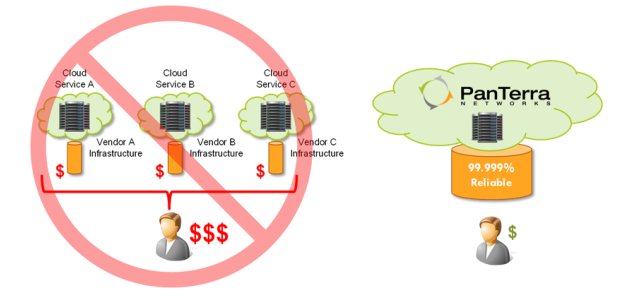
The economics of moving an on-premises based IT service to the cloud can be compelling, especially when the total cost of providing that service is measured. CAPEX is significantly reduced or even eliminated in some cases. Tradition OPEX costs such as maintenance and support contracts, truck-roll repairs, part sparing and additional IT resources to support and maintain onpremises equipment are replaced with dynamically adjustable cloud services.
The economics of moving several IT services to the cloud become more complicated. Consider an enterprise that wants to move their file storage, communications and collaboration services to the cloud. Assume each cloud service is provided by a separate cloud service provider. Each service provider will have a “minimum” per user per month amount they will charge for their service. This “entry fee” is the minimum charge the provider needs in order to stay in business and make some profit. It pays for the infrastructure cost of providing the services (datacenters, networks, electricity, operations personnel). Thus in our example, the enterprise is paying the “entry fee” three times for each cloud service. This can add up to a lot of money per user per month (>$100). When you compare this to the on-premises OPEX costs, the “break even” point may never be reached for the multi-cloud services implementation.
Now, compare the movement of the three cloud services to a single Unified Cloud Service provider. Such UCS provider only charges the “entry fee” once to cover the infrastructure costs. Thus a UCS provider can deliver all three cloud services at a much lower per user per month cost to the enterprise. This brings the economic trade-off measurement back in line with single cloud service implementations and provides a compelling OPEX savings for enterprises. The economics only get better as more and more services are moved to and delivered by a UCS provider as opposed to multiple single service providers.
Interservice Integration

Enterprises depend on many infrastructure services to run their business and deliver productivity tools to their employees. Everyone benefits when these services work together in a seamless fashion. Conversely, excessive IT resources are required and worker productivity suffers when services are compartmentalized and disjointed. Unfortunately, by its very nature, cloud services from multiple service providers will have limited if any inter-service integration.
Services delivered from a UCS provider and especially a UCS provider that is also a technology provider have an inherent ability to seamlessly work together with high levels of inter-service integration. This delivers the following benefits to an enterprise:
Consistent Quality of Service – Cloud services delivered from a single UCS provider have the ability to “know” what resources each service is using or requesting and can prioritize those resources so that the most important services receive more resources. This allows users to experience higher levels of QoS.
Improved Worker Productivity – When cloud services are seamlessly integrated, users experience less unnecessary redundant operations such as multiple logins and disjoint separate dashboards. Users can do their work within a single framework and access all necessary services without interrupting their work flow or process. Data re entry (such as entering email addresses multiple times) is reduced or eliminated.
Reduced IT Resources – When IT services seamlessly work together and have common unified administration and management portals, IT resource demands can be significantly reduced. This doesn’t necessarily mean reduced IT staff. IT resources can be redirected to more important projects.
STREAMS: PANTERRA’S UNIFIED CLOUD SERVICE SOLUTION
As a Unified Cloud Services provider, PanTerra delivers a broad spectrum of infrastructure services including Unified Communications, Cloud Storage and Mobility services. This seamlessly integrated unified cloud approach virtually eliminating an enterprise’s capital inefficient datacenter expenses, lowering overall IT operating costs, maximizing productivity and eliminating costly multi-vendor cloud service redundancies. Enterprises now have a single administration portal to manage and administer all their cloud services consistently across all employees around the world.

Streams services can be mixed and matched to the requirements of each individual employee within the enterprise and changes to services can be done instantly from a secure browser. As new features and services become available from PanTerra, they are instantly available to an enterprise, creating a futureproof IT infrastructure that ensures access to leading edge IT technology to keep your enterprise at maximum competitiveness. Streams unified cloud service delivers the following benefits:
Security – Streams delivers the highest level of security available today with hardened data centers, encryption during transit and at rest and multi-mode authentication for all devices accessing the service. Multi-mode authentication protects the user’s communications and content from unauthorized access or abuse even if the user’s login credentials are compromised or their mobile devices are stolen!
Reliability and Availability – Streams’ hardened redundancy delivers the highest level of reliability available today. Historical service availability had been maintained at 99.999% availability.
Scalability – Streams is 100% cloud implemented and deployed, making it virtually infinitely scalable to handling even the most demanding enterprise growth scenarios.
QoS – QoS is implemented not only within each cloud service, but between cloud services, ensuring smooth reliable delivering of each service and optimal prioritization of services should the need arise.
Support – PanTerra Networks provides 24/7/365 “instant support”, guaranteeing through our SLA a 30 second response time for any customer issues. Support is provided through multiple avenues, including calling, email, IM, fax and desktop sharing.
SLA – PanTerra Networks guarantees its cloud services through the industry’s highest Service Level Agreement (SLA), which ensures a consistent level of service for all services. This gives consistent peace of mind to IT groups while leverage the unified multi-service PanTerra Networks architecture.
About PanTerra Networks
PanTerra Networks, Inc. is the premier service provider of Unified Cloud Services (UCS). Streams represents a new era in cloud services, unifying and integrating multiple cloud services together. By unifying the most critical IT services into a single solution, Streams significantly reduces capital equipment expense and associated obsolescence, reduces ongoing operating expenses, increases productivity and competitiveness, and creates an elastic and futureproof infrastructure ideally suited for today’s dynamic business environment. With Streams, enterprises can focus all their resources on their core competencies and not their infrastructure.
PanTerra Networks is privately held and is headquartered in Sunnyvale, California. For more information, please visit http://www.panterranetworks.com or call us at +1 800.805.0558 or email us at info@panterranetworks.com.
.jpg?width=500&height=500&name=Are%20you%20Getting%20a%20Good%20Deal%20(1).jpg)
Comments